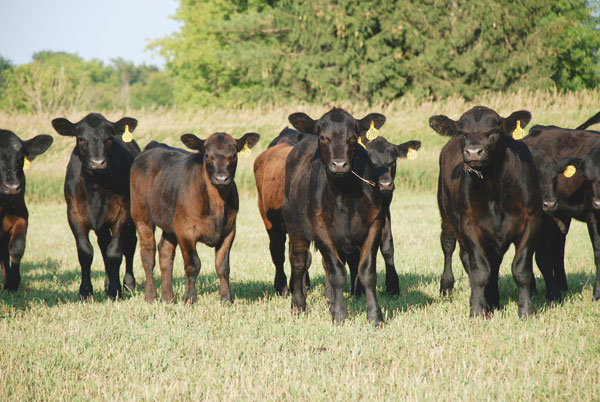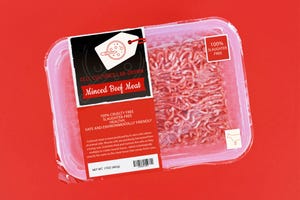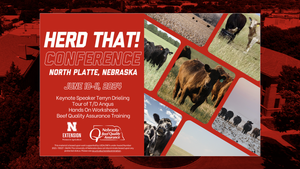5 management steps to boost calf performance & profit
April 27, 2015

Producing and selling a healthy, heavy, high-quality calf should be the goal of all beef producers. The importance of calf vigor, heterosis and adequate intake of quality colostrum are well-understood and critical, but there are other important boxes to check off as well, and they can add up to significant dollars.
1. Flies pester calves from spring to fall, and we have many tools at our disposal to control them. Ask your herd health veterinarian about fly tags, insecticide feed additives, sprays, pour-ons and dust bags. All these preventive strategies can be cost-effective in certain situations. Don’t allow flies to infest cows and calves all summer.
2. While studies on deworming of nursing calves are controversial, the trials on deworming their dams sometime around pasture turnout are less disputable. The cows are shedding many parasite eggs, and deworming cows decreases pasture contamination, which lessens exposure for the entire herd.
3. The vast majority of cow-calf producers should implant their nursing calves, as trials show a daily gain improvement of 0.10 to 0.14 pound during the suckling phase. Producers of organic and all-natural beef will forgo this improvement in gain for an equal or superior enhancement in revenue due to a program price advantage. However, such calves must be contracted ahead of sale, so if you market your weaned calves through a feeder auction, I can almost guarantee there will be no “bonus” for non-implanted feeder calves in this venue.
Suckling implants work primarily by improving the efficiency of the milk and grass the calf ingests. This produces more muscle mass, which improves weaning weight.

70+ photos showcasing all types of cattle nutrition
Readers share their favorite photos of cattle grazing or steers bellied up to the feedbunk. See reader favorite nutrition photos here.
Data from the National Animal Health Monitoring System from 1997 indicates only 14.3% of all cow-calf producers implanted suckling calves, while 55.4% of those with more than 300 cows utilized the technology. But even in large herds, this technology is underutilized, as the 2008 survey showed slightly less utilization than in 1997.
In contrast, 90% of cattle in North America are implanted during the feedlot stage.
If a non-implanted steer weighs 500 pounds at sale time, his projected worth this fall is about $1,155. If he’s implanted and weighs 520 pounds, he’s worth about $1,175. The payoff for a $1 investment in the implant is $20. If you implant 100 calves in an hour, that’s $2,000 for that hour of work. What other legal work provides that kind of return?
What’s more, a Colorado State University study with 550 steers showed the suckling implant had no effect on marbling score, shear force, consumer ratings or tenderness of that animal at harvest.
4. Suckling heifers can also be implanted. However, if they might be kept for breeding, only a single low-dose implant should be administered between 45 days of age and weaning. If a heifer will be kept for breeding, there is no implant advantage. Never implant bull calves.
5. Bull calves should be castrated at less than 3 months of age. Calves castrated early do not experience the stress of those castrated late. Calves castrated near weaning have a one- to two-week period of weight loss soon after castration that is never regained. Meanwhile, late castrates have lower-quality grade and decreased tenderness compared to calves castrated early.
The ideal scenario for optimal calf weaning weight is to castrate near birth and then implant sometime in the suckling phase with a low-dose implant. We are at near-record high prices in the beef industry and profits are excellent. But why leave money on the table?
Calves that don’t have to fight internal and external parasites are healthier and produce greater profits. A technology like a growth implant is positive for the producer and the environment because we can produce more pounds of beef on the same land base. Implants also improve carcass weight.
With our national supply at an all-time low, we could use the extra beef to help satisfy a few more consumers’ demand for beef.
W. Mark Hilton, DVM, is a clinical professor of beef production medicine at Purdue University in West Lafayette, Ind.
You might also like:
12 new products for the ranch this spring
Cattle aren't the water guzzlers they're made out to be
60 stunning photos that showcase ranch work ethics
Must-Read: Montana couple uses "construction" cones to help herd cattle
6 steps to low-input cow herd feeding
Meet the U.S. cattle operations honored for stewardship efforts
Q&A: Nutrition author says dietary recommendations are "shockingly" unscientific
About the Author(s)
You May Also Like



